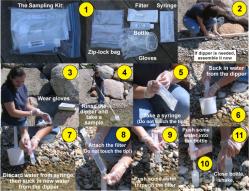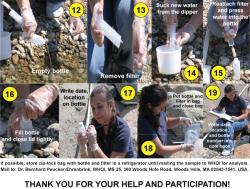A little bit a water goes a long way. Our analytical machines (ion chromotographs and mass spectrometers) are so sensitive that we only need a few milliliters of water to measure anions (negatively charged species such as chloride, sulfate and nitrate) and major cations (positively charged species such as calcium, magnesium, potassium, sodium) in a river water sample. We need a little bit more water (20 milliliters) to measure elements that are very rare in water, such as strontium, rubidium, barium, rhenium and uranium. Some of these elements are particularly interesting to us, because they exist in different "flavors" (called "isotopes"). In order to "taste" these flavors we need even more water. For instance, the element strontium comes in four different flavors (the experts call them Sr-84, Sr-86, Sr-87, and Sr-88, for the number of elementary building blocks in their atomic cores). To measure the abundance of these flavors of strontium in a typcial river we need not quite a full bottle of water, about 50-100 milliliters. You see, we can do a lot with one bottle of properly filtered river water. But we can only do it with your help... If you are interested in helping us please contact Bernhard Peucker-Ehrenbrink (behrenbrink@whoi.edu) If you live or spend time near a river that interests us (most large rivers close to the ocean, but not so close that the river water tastes salty) we will send you a sampling kit with the sampling instructions. All you have to do is to go out, take a sample of your river and mail it back to us. We will then get to work in our laboratories, so the tedious analytical work ;-) and write you an email with the results when we are done. Please be patient, the analytical work will take a while... ...want to see how we do the sampling in the field?.. To the right we provide links to short movies that show how we sample rivers for dissolved and particulate matter. Each of the five movie is available in QuickTime (.mov) and Windows (.wmv) files. Last updated: October 11, 2012 | |||||||||||||||||||||||
Copyright ©2007 Woods Hole Oceanographic Institution, All Rights Reserved, Privacy Policy. | |||||||||||||||||||||||


